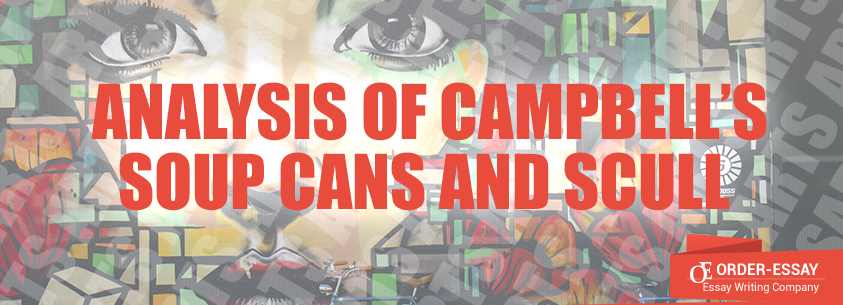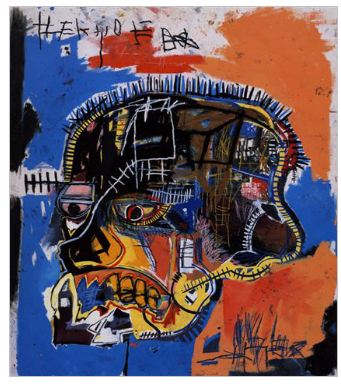
Jean-Michel Basquiat and Andy Warhol are famous American artists of the 20th century. This paper focuses on such works as Scull and Campbell’s Soup Cans, created by Basquiat and Warhol respectively. Campbell’s Soup Cans is a collection of cans that depict the various soup flavors offered by a food producing company of that time. Scull is a magnificent piece of art that depicts an incomplete face of a person. This paper discusses both artworks, analyzing the similarity between them and the way that the works of Basquiat and Warhol promoted the popular art.
Need custom written paper? We'll write an essay from scratch according to your instructions!
Plagiarism and AI Free
Price from only 10.99$/page
Call Now
Start Chat
Order Now
Analysis of Basquiat’s Skull
Jean-Michel Basquiat is a Neo-Expressionist, who created in the scope of punk art, a popular movement of the period from 1969 to 1989. Basquiat’s Scull is an example of how the American punk movement was recognized as a popular art. The use of graffiti in Scull is an element associated with Afro-Americans, who at that period used graffiti drawings for purposes of expressing themselves.
In this painting, Basquiat depicts the head of a man, which with its shape and sharp lines resembles a skull. The head is divided into segments and decorated with patterns that remind newly stitched scars and wounds, in the colors of yellow, turquoise and orange (Basquiat 1). Through this artwork, Basquiat seeks to identify the grievances that African-Americans had to face. The use of heavy coloring is an element typical of pop painting and neo-expressionism. Using these colors to depict the wounds, Basquiat manages to create a shambled face. It indicates the unhappiness that the artist was feeling because of the racial discrimination against Afro-Americans in America (Hooks 44).

Fig. 1. Jean Michel Basquiat; “Scull”; Broad Collection, Los Angeles, USA; 1981; Web. 18 Oct. 2015.
Analysis of Warhol’s Campbell’s Soup Cans
Andy Warhol is another prominent figure in the American pop art. Having a degree in commercial arts, the artist found inspiration for most of his paintings and drawings in this sphere (Warhol and Joseph 11). Campbell’s Soup Cans is a neo-expressionist artwork intended both to promote a product and serve as an artistic expression. While designing Campbell’s Soup Cans, Warhol sought to point to the eating habits of society. The painting shows the ridiculousness of eating the same food for over 20 years, thus depicting 32 identical cans of food.
Commercialization of art is another important aspect that the painting depicts. The words “The Campbell’s Soup” in red indicate that the product named is being promoted. This is an example of an advertisement, which relies on art to convey its message to the target market (Warhol and Joseph 51). The 1960s was a period that saw the emergence of mass consumerism as a culture and, to capture a particular market, there was a need of advertising. Therefore, Campbell’s Soup Cans entrenches the culture of pop art that involves the combination of themes and images from the commercial media and customers. For example, during the 1960s, paintings did not comprise of labeled cans; however, Warhol intentionally used labels in his painting.
From the historical perspective, this painting is a rejection of the historical formalist doctrine that shaped the world of painting. The invention of photography prevented artists from painting elaborated works with many details. Hence, most painters concentrated on shapes and colors for their paintings. Campbell’s Soup Cans can challenge this principle because of the extensive details Warhol introduced in the painting (Warhol 1).

Fig. 2. Andy Warhol; “The Campbell’s Soup Cans”;



Where the Two Works Intersect
Both the two works seek to promote an element of identity. In the Scull, Basquiat seeks to promote the notion of black identity and the struggles they were passing through. The Scull is a shambled face of an individual, and the picture contains some elements of graffiti. Graffiti is symbolically attributed to African-Americans. Hence, the painting depicts this class of people. In the 1960s, through the 1980s, African-Americans were passing through discrimination and racialism. There was a lot of poverty, and most of them were on streets. The painting seeks to depict this situation. The Campbell’s Soup Cans also promote an element of identity. While coming up with the paintings, Warhol was a commercial artist. During this period of time, United States was characterized by commercial consumerism. Companies resorted to advertising their products; hence the use of artists. The Campbell’s Soup Cans therefore aims at identifying the culture that was dominant at the time; that is, consumerism.
Get a Price Quote
The use of color and line to pass to depict an element of neo-expressionism is one area that they intersect. Both Campbell’s Soup Cans and the Scull are examples of neo-expressionist art. One of the most distinctive features of Neo-expressionism is the heavy use of color to produce an image. Basquiat uses more than four colors to produce his shambled painting (Saggese 109). These colors are black, white, blue, red and yellow. In contrast, Warhol relies on red and white to create the paintings of the cans in a chronological order. Another thing that connects the two works is the way they served to promote popular art. Both Basquiat and Warhol used their paintings to enhance the public interest in modern art: Basquiat used elements of graffiti in his work, and Warhol’s painting is related to advertisement. This way, both artworks appealed to a wider audience than those who are subjectively interested in art.








